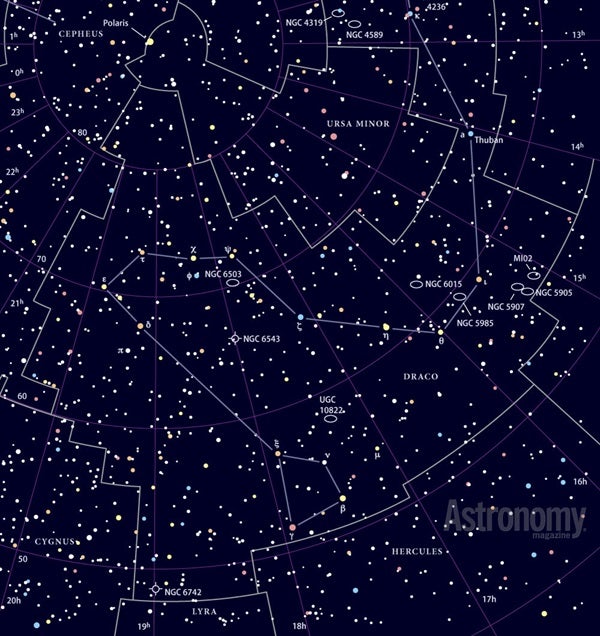Targets for July 9–16, 2015
Small telescope:
Open cluster M21
Small telescope:
Globular cluster NGC 6554
Large telescope:
The Lost in Space Galaxy (NGC 6503)
This week’s first small-telescope target is the 21st entry in French comet-hunter Charles Messier’s famous list. M21 is an open cluster that shines at magnitude 5.9 and measures 13′ across.
You’ll find this relatively unobserved Messier object 2.6° southwest of magnitude 3.8 Mu (μ) Sagittarii. I’m pretty certain you’ll sweep up the Trifid Nebula (M20) first, so when you do, move 42′ northeast for M21.
Through a 6-inch telescope, you’ll see two dozen stars brighter than 12th magnitude. The magnitude 7.2 star SAO 186215 shines at the cluster’s center.
A round triangle?
This week’s second small-scope object is globular cluster NGC 6553 in Sagittarius. It’s relatively bright for a globular cluster, shining at magnitude 8.2. And its diameter of 9.2′ means it occupies 9 percent of the area covered by the Full Moon.
To find it, look 4.2° west of magnitude 2.8 Kaus Borealis (Lambda [λ] Sagittarii). Through a 4-inch telescope at 150x from a dark site, you’ll see this cluster’s somewhat triangular appearance. I think of it as an arrowhead pointing toward the southeast. The arrowhead’s northeast tip is the brightest. Look for two stars of about magnitude 11.6, each less than 1′ from the cluster’s center. One lies to the northeast and the other toward the west-southwest.
Danger, Will Robinson!
This week’s large-telescope target is the Lost in Space Galaxy, otherwise known as NGC 6503 in Draco.
This target is a magnitude 10.3 spiral galaxy you can spot easily through a 4-inch telescope from a dark site, but you’ll want a larger instrument to pull out its details. Find this galaxy by starting at magnitude 4.9 Omega (ω) Draconis and moving 1.8° northeast.
NGC 6503 spans 7.3′ by 2.4′. It displays a broadly concentrated region offset to the north of center. The galaxy’s surface mottling becomes apparent through a 16-inch scope. Measurements of the brightest blue stars place NGC 6503 at 17 million light-years.
When I first heard Astronomy magazine Contributing Editor Stephen James O’Meara’s common name for this object, I thought he was referring to the television series Lost in Space, which ran from 1965 to 1968. As a big fan of science fiction, I loved the perceived tie-in. But no. O’Meara dubbed it the Lost in Space Galaxy simply because of its isolation and neglect (by observers).
Expand your observing at Astronomy.com
StarDome
Check out Astronomy.com’s interactive StarDome to see an accurate map of your sky. This tool will help you locate this week’s targets.
The Sky this Week
Get a daily digest of celestial events coming soon to a sky near you.
Observing Talk
After you listen to the podcast and try to find the objects, be sure to share your observing experience with us by leaving a comment at the blog or in the Reader Forums.











